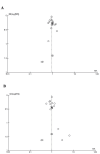Clinical Outcomes of Polymer-Free Versus Polymer-Coated Drug-Eluting Stents in Patients With Coronary Artery Disease: A Systematic Review and Meta-Analysis
- PMID: 37252538
- PMCID: PMC10224769
- DOI: 10.7759/cureus.38215
Clinical Outcomes of Polymer-Free Versus Polymer-Coated Drug-Eluting Stents in Patients With Coronary Artery Disease: A Systematic Review and Meta-Analysis
Abstract
Drug-eluting stents have transformed the treatment of coronary artery disease (CAD), and there are two types: polymer-free and polymer-coated stents. Polymer-free stents have a coating that is quickly absorbed by the body, whereas polymer-coated stents have a coating that remains on the stent surface. This meta-analysis and systematic review aimed to compare the clinical outcomes of these two stent types in patients with coronary artery disease. The literature and abstracts from significant databases were reviewed to compare polymer-free drug-eluting stents (PF-DES) and polymer-coated drug-eluting stents (PC-DES) for the treatment of coronary artery disease (CAD). The primary efficacy endpoints of the study were all-cause mortality and deaths from cardiovascular and non-cardiovascular causes. Among the secondary outcomes were incidences of myocardial infarction (MI), target lesion revascularization (TLR), target vessel revascularization (TVR), stent thrombosis, stroke, and major adverse cardiovascular events (MACEs). In terms of the primary outcomes, the combined analysis revealed a marginally lower risk of all-cause mortality (relative risk, RR (95% CI) = 0.92 (0.85, 1.00), p = 0.05, I2 = 0%) with the use of PF-DES versus PC-DES. Nonetheless, there was no significant difference in cardiovascular mortality (RR (95% CI) = 0.97 (0.87, 1.08)) or non-cardiovascular mortality (RR (95% CI) = 0.87 (0.69, 1.10), p = 0.25, I2 = 9%) between the groups. Furthermore, univariate meta-regression revealed that male gender and prior myocardial infarction were independently associated with an increased risk of all-cause mortality and cardiovascular disease. According to the current meta-analysis, no statistically significant differences existed in PF-DES and PC-DES outcomes. More extensive research is needed to investigate these findings further and establish their validity.
Keywords: cad; coronary artery disease; drug-eluting stent; meta-analysis; pc-des; pf-des; polymer coated; polymer-free; systematic review.
Copyright © 2023, Khatri et al.
Conflict of interest statement
The authors have declared that no competing interests exist.
Figures













References
-
- Durable polymer versus biodegradable polymer drug-eluting stents after percutaneous coronary intervention in patients with acute coronary syndrome: the HOST-REDUCE-POLYTECH-ACS trial. Kim HS, Kang J, Hwang D, et al. Circulation. 2021;143:1081–1091. - PubMed
Publication types
LinkOut - more resources
Full Text Sources
Miscellaneous
